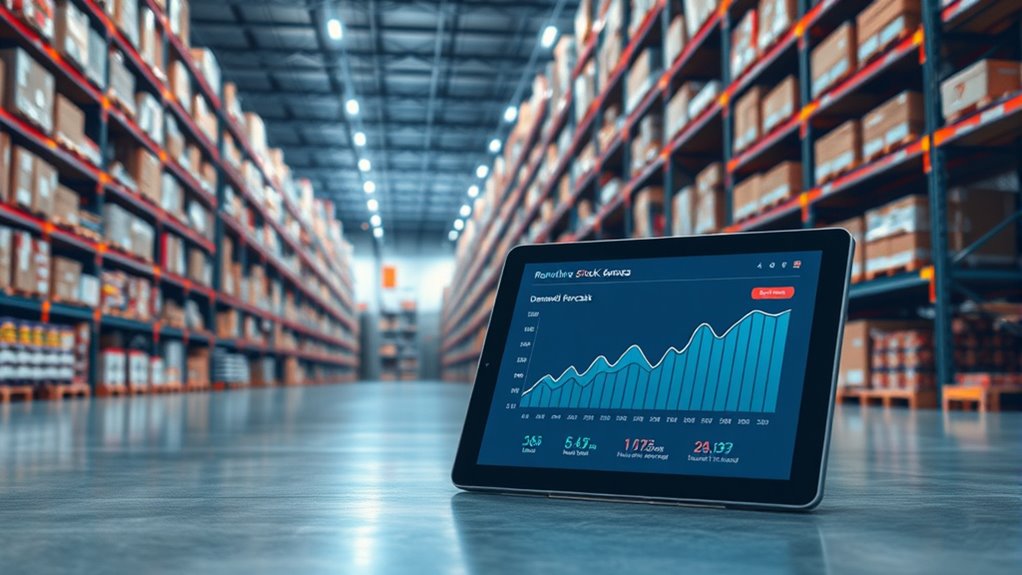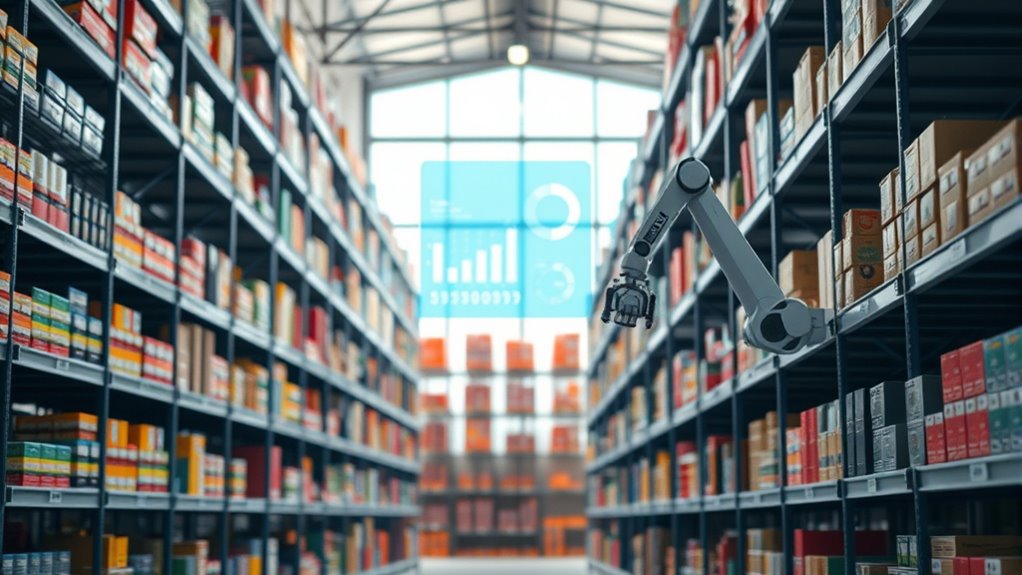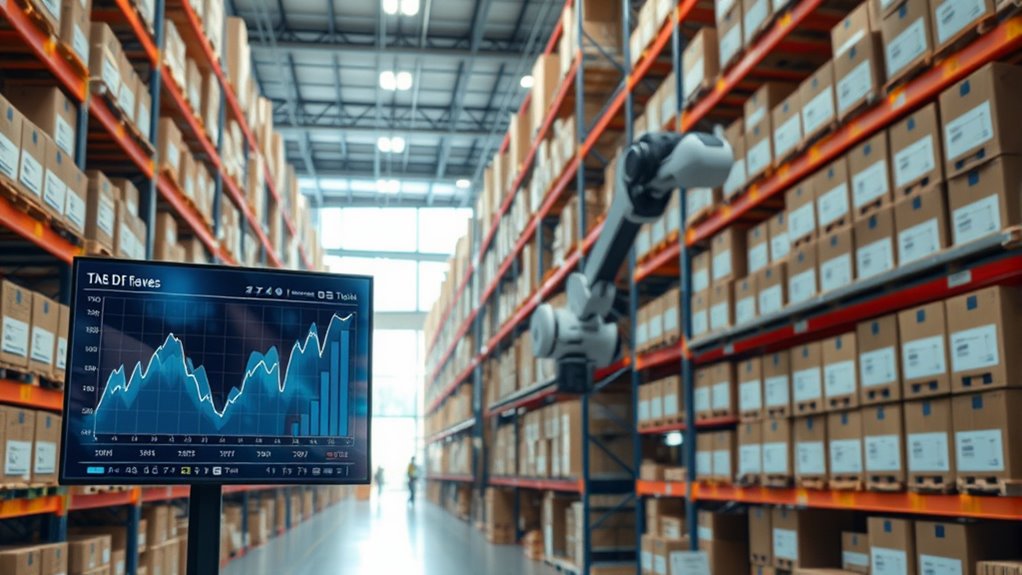AI transforms inventory management by optimizing stock levels with predictive analytics and real-time tracking. It analyzes historical sales data and market trends to forecast demand accurately, reducing stockouts and overstock situations. You can automate replenishment processes, ensuring that you’re always stocked appropriately. Utilizing technologies like IoT and barcode systems, you gain visibility into inventory status. By embracing these AI-driven strategies, you’re setting your business up for success—there’s even more to explore on this topic.
Key Takeaways
- AI leverages predictive analytics to accurately forecast demand and optimize stock levels, reducing stockouts and overstocking.
- Real-time inventory tracking with IoT and RFID provides visibility, ensuring timely replenishment and accurate stock management.
- Automated inventory threshold management triggers reorders when stock dips below predefined levels, enhancing supply chain efficiency.
- AI-driven inventory segmentation categorizes products to optimize resource allocation and maximize profitability based on demand.
- Continuous data analysis through AI minimizes holding costs by reducing inventory levels and improving distribution strategies.
Understanding AI in Inventory Management

As you explore the role of AI in inventory management, you’ll discover that it revolutionizes how businesses handle stock and supply chains.
AI processes vast datasets quickly, enabling accurate data analysis that manual methods can’t match. It identifies trends in sales data, enhancing your understanding of customer behavior.
AI rapidly analyzes extensive datasets, revealing sales trends and deepening insights into customer behavior.
By automating tasks like data entry and inventory tracking, AI reduces errors and boosts efficiency. With real-time visibility, you can monitor inventory across the supply chain seamlessly.
Plus, AI generates valuable insights, supporting strategic decisions about stock levels and demand. Techniques like machine learning and inventory segmentation further optimize inventory management, ensuring you maintain the right stock to meet customer needs while minimizing costs and waste.
The Role of Predictive Analytics

AI’s ability to analyze vast amounts of data sets the stage for predictive analytics in inventory management.
Predictive analytics leverages statistical algorithms and machine learning to examine historical data, helping you forecast future demand accurately. By integrating sales data, market trends, and customer behavior into your inventory system, you can optimize stock levels effectively.
This approach minimizes stockouts and overstocking, ensuring you maintain the right inventory balance. Predictive models also enhance safety stock management, shielding you from demand fluctuations.
With real-time data processing, you can make quicker decisions, boosting operational efficiency. Ultimately, adopting predictive analytics helps reduce inventory holding costs, streamlining your inventory processes while improving overall customer satisfaction.
Enhancing Demand Forecasting

To enhance demand forecasting, leveraging advanced AI algorithms can significantly improve accuracy and efficiency.
By utilizing machine learning models, you can continuously analyze historical sales data and external factors, adapting to market changes as they occur. These AI-driven forecasts achieve lower Mean Absolute Error (MAE) and Root Mean Squared Error (RMSE) compared to traditional methods, ensuring you’re making informed decisions.
Harnessing machine learning for sales data analysis leads to more accurate forecasts, minimizing errors and empowering informed decision-making.
Integrating AI with your inventory systems automates replenishment processes based on real-time predictions, helping maintain optimal stock levels.
Additionally, considering factors like seasonality and promotions enhances your forecasting precision, reducing the risk of stockouts and excess inventory.
Ultimately, this approach streamlines your operations and boosts customer satisfaction.
Real-Time Inventory Tracking Technologies
Accurate demand forecasting sets the stage for effective inventory management, but real-time inventory tracking technologies are what truly bring those forecasts to life.
With barcode technology, you can automatically update inventory levels, reducing manual errors. RFID technology lets you track inventory location and movement effortlessly. The Internet of Things (IoT) continuously monitors stock levels, while machine learning analyzes historical trends to predict needs.
Cloud-based systems enable remote monitoring across multiple locations. Key components like automated data capture and centralized data management ensure efficiency.
You’ll benefit from enhanced accuracy, improved decision-making, and reduced operational costs. Integrating these systems with e-commerce platforms and ERP systems streamlines your processes, allowing for better customer satisfaction and proactive inventory management.
The Importance of Inventory Visibility
When you have clear inventory visibility, it enhances your decision-making processes and helps you reduce stock discrepancies.
This clarity streamlines your operations, allowing you to respond quickly to changes in demand.
Ultimately, it sets the stage for a more efficient and effective inventory management strategy.
Enhanced Decision-Making Processes
While effective inventory management hinges on various factors, inventory visibility stands out as a crucial element that significantly enhances decision-making processes.
With real-time data analysis, you can make informed decisions swiftly, adapting to changes in demand or supply. Predictive analytics leverages historical data to forecast future demand, optimizing stock levels and minimizing errors.
Continuous inventory tracking allows you to stay updated, while automated decision-making frees up resources for more strategic initiatives. AI generates actionable insights from your inventory data, enabling you to refine your management strategies effectively.
Reduced Stock Discrepancies
To effectively manage your inventory, visibility is key in reducing stock discrepancies. AI-powered monitoring continuously checks your inventory levels against sales data, quickly identifying any discrepancies.
Automated stocktaking technologies, like computer vision and barcode scanning, cut down on manual errors, making your data more reliable. With real-time tracking, you gain instant insights into inventory across multiple locations, enhancing overall accuracy.
Predictive analysis helps anticipate demand, further minimizing discrepancies. Plus, AI integrates returned items with your inventory records, ensuring stock levels are updated promptly.
This level of visibility not only reduces waste but also improves customer satisfaction by guaranteeing product availability. Ultimately, accurate inventory management saves costs and streamlines your operations.
Streamlined Operations Efficiency
Inventory visibility plays a crucial role in streamlining operations efficiency, as it equips you with real-time insights into stock levels and locations. This information allows you to make informed decisions, reducing operational costs and improving response times.
By integrating advanced technologies like AI and IoT, you can enhance inventory tracking and management, ensuring optimal stock levels. Real-time monitoring helps you quickly address demand changes or supply chain disruptions, maintaining continuous operations.
Key efficiency metrics, such as reduced lead times and improved order fulfillment rates, reflect your enhanced agility. With high inventory visibility, you can adapt swiftly to market shifts, boosting your competitive edge and elevating customer satisfaction.
Embrace this visibility to transform your operational efficiency.
Automating Replenishment Processes

When you automate replenishment processes, you’re streamlining your supply chain operations.
AI-driven algorithms help manage inventory thresholds effectively, ensuring you always have the right stock on hand. This not only boosts efficiency but also minimizes the risk of stockouts and overstocking.
AI-Driven Replenishment Algorithms
As businesses strive for efficiency in today’s fast-paced market, AI-driven replenishment algorithms have emerged as a game-changer in automating replenishment processes.
These algorithms analyze historical sales data and external factors to forecast demand accurately, reducing both overstocking and stockouts. By processing real-time data from sources like POS systems and IoT devices, AI optimizes replenishment decisions and minimizes manual intervention.
With machine learning, models continuously refine forecasts based on new information, enhancing accuracy over time. Furthermore, integrating technologies like IoT and robotic process automation streamlines ordering and receiving, improving supply chain efficiency.
Ultimately, these AI-driven solutions boost operational efficiency, enhance customer satisfaction, and provide a competitive edge in inventory management.
Inventory Threshold Management
To maintain seamless operations and prevent stockouts, effective inventory threshold management is essential for businesses. Setting inventory thresholds defines the minimum quantity of products you need to keep in stock, ensuring continuous supply.
Automated systems simplify this process, offering real-time tracking and alerts when stock falls below these thresholds. Unlike manual management, which can be error-prone, automation allows you to set thresholds universally or for specific product categories.
Integrating ERP systems can further enhance your inventory management by providing accurate feeds on stock levels. By leveraging AI tools, you can forecast demand and automate replenishment processes, helping you maintain optimal inventory levels and avoid lost sales.
This smart approach ultimately saves costs and boosts efficiency.
Streamlined Supply Chain Operations
Streamlining supply chain operations through automated replenishment processes can significantly enhance your inventory management. By leveraging AI, you can automate reordering based on predicted demand and real-time inventory levels, which prevents stockouts and ensures timely restocking.
AI systems can trigger orders automatically when stock dips below predefined thresholds, maintaining optimal inventory levels effortlessly. Additionally, these tools monitor supplier performance, fostering reliable supply chains and reducing lead times.
With predictive analytics, you gain insights into demand patterns, improving decision-making. As a result, you’ll experience increased operational efficiency, potentially reducing costs by up to 30%.
Embracing automation in your replenishment processes empowers you to manage inventory more effectively while enhancing overall supply chain visibility.
Strategies for Inventory Optimization

While managing inventory can be complex, leveraging AI strategies can significantly simplify the process and enhance efficiency.
Start by utilizing real-time monitoring to get instant alerts for stock adjustments, ensuring you never run low on essential items.
Implement demand forecasting to analyze historical data and market trends, helping you anticipate customer needs.
Use inventory segmentation to categorize products based on demand and profitability, allowing for smarter resource allocation.
Automate reordering based on sales velocity, and consider dynamic pricing strategies to maximize profits during supply constraints.
Cost Reduction Through AI

By harnessing AI for inventory management, businesses can achieve substantial cost reductions that directly impact their bottom line.
AI can help you reduce inventory levels by 20-50%, cutting down on holding costs tied to excess stock. You’ll also minimize overstock and deadstock, reducing costly markdowns and enhancing profit margins.
Additionally, AI optimizes inventory distribution, saving you 15-30% on shipping costs. Automating routine tasks lowers labor costs, allowing your team to focus on strategic initiatives.
With improved demand forecasting and real-time data analysis, you can further reduce errors and unnecessary stock.
All these factors lead to significant annual savings and improved cash flow, ensuring your operations remain cost-efficient and profitable.
Achieving Competitive Advantage

To achieve a competitive advantage, you need to focus on enhanced operational efficiency and strategic market adaptability.
Enhanced Operational Efficiency
In today’s fast-paced market, leveraging AI for inventory management can significantly enhance operational efficiency and give you a competitive edge.
AI’s predictive analytics analyze historical data and market trends, helping you accurately forecast demand and optimize stock levels. With real-time inventory tracking, you can monitor stock across all locations, ensuring timely updates.
Automated processes handle routine tasks like inventory counting and ordering, cutting down manual labor and errors. AI also optimizes your supply chain by selecting the best suppliers and maintaining ideal order quantities.
With data-driven dashboards, you gain instant access to critical inventory metrics, enabling quick, informed decisions that boost your operational efficiency and streamline your inventory management. Furthermore, AI integration in healthcare is anticipated to improve diagnostics accuracy, showcasing the broader impact of AI across various sectors.
Strategic Market Adaptability
As market conditions shift rapidly, adapting your inventory management strategies becomes crucial for maintaining a competitive edge.
AI enhances demand forecasting by analyzing historical data and market trends, allowing you to align inventory levels with current demand. By leveraging competitive intelligence, you gain insights into rivals’ strategies, helping you stay proactive in dynamic markets.
AI also builds supply chain resilience by predicting disruptions, ensuring continuous operations. With real-time data analysis and predictive analytics, you can minimize overstocking and stockouts effectively.
Tailoring your inventory management to customer preferences boosts satisfaction while automated decision-making ensures swift responses to changes. Embracing these AI-driven strategies equips you to navigate challenges and seize opportunities in the ever-evolving marketplace.
The Future Landscape of AI in Supply Chains

While many industries are already experiencing the transformative effects of artificial intelligence, the future landscape of AI in supply chains promises even greater advancements.
You’ll likely see predictive analytics become essential for demand forecasting, helping you maintain optimal stock levels and minimize stockouts.
Real-time adjustments will enhance operational efficiency, allowing you to respond swiftly to market changes.
AI-driven automation will streamline processes from procurement to delivery, increasing speed and reducing human error.
As AI integrates with IoT and advanced technologies, you’ll benefit from improved data analysis and risk assessment.
Embracing these innovations won’t only enhance efficiency but also promote sustainability, positioning your supply chain for future success. Additionally, understanding market volatility will be crucial as you adapt to dynamic supply chain challenges.
Frequently Asked Questions
How Can Small Businesses Implement AI Inventory Management Effectively?
To implement AI inventory management effectively, start by identifying your specific pain points, like stockouts or overstocking.
Set clear business goals, then evaluate your current systems for compatibility with AI tools.
Research available options, focusing on features that suit your needs.
Begin with basic automation to streamline tasks and provide training for your staff.
Finally, continuously monitor performance and adjust strategies to ensure your inventory operations remain efficient and aligned with your business objectives.
What Are Common Challenges in Adopting AI for Inventory Management?
Adopting AI can be a daunting dance, filled with data dilemmas, daunting costs, and cultural clashes.
You’ll face hurdles like data accuracy and integration issues, which can cloud your predictions. Initial investments might strain your budget, and skilled personnel are often scarce.
Plus, resistance from your team can create a culture of hesitation. To succeed, you’ll need strong leadership, clear communication, and a commitment to embracing change and continuous learning.
How Does AI Impact Employee Roles in Inventory Management?
AI significantly transforms your role in inventory management.
You’ll find yourself shifting from manual tasks to strategic planning, allowing you to focus on supplier negotiations and customer service.
With AI handling routine processes, you’ll experience reduced workloads and improved accuracy in tracking inventory.
This change demands you develop new skills, like data analysis and strategic thinking, ensuring you adapt effectively to the evolving landscape of AI-driven operations.
Continuous learning will be essential.
What Types of Businesses Benefit Most From AI Inventory Solutions?
If you’re in retail, e-commerce, or manufacturing, you’ll find AI inventory solutions incredibly beneficial.
These industries thrive on accurate demand forecasting and real-time tracking, helping you minimize costs and boost customer satisfaction.
Logistics also gains from AI, streamlining deliveries and optimizing routes.
Essentially, any business looking to enhance efficiency, reduce errors, and improve supply chain performance will see significant advantages from integrating AI into their inventory management processes.
How Can Businesses Measure the Success of AI in Inventory Management?
To measure the success of AI in inventory management, you can track key performance indicators like inventory turnover and days inventory outstanding.
Monitor operational efficiency metrics, such as automated tasks and real-time monitoring.
Don’t forget financial impact metrics like cost savings and ROI.
Finally, assess customer satisfaction through order fulfillment rates and feedback.
Conclusion
In a world where inventory chaos reigns supreme, embracing AI isn’t just a choice—it’s your golden ticket to unparalleled efficiency! By harnessing the power of predictive analytics and real-time tracking, you’re not just optimizing stock levels; you’re practically becoming a supply chain superhero. Imagine slashing costs and outsmarting competitors with a mere flick of your digital wand! The future of inventory management is dazzling, and you’re right at the forefront, ready to conquer the chaos like never before!










